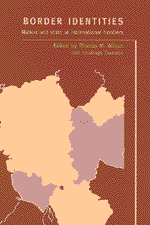Book contents
- Frontmatter
- Contents
- List of maps
- List of contributors
- Acknowledgements
- 1 Nation, state and identity at international borders
- 2 State formation and national identity in the Catalan borderlands during the eighteenth and nineteenth centuries
- 3 A western perspective on an eastern interpretation of where north meets south: Pyrenean borderland cultures
- 4 The ‘new immigration’ and the transformation of the European-African frontier
- 5 Transnationalism in California and Mexico at the end of empire
- 6 National identity on the frontier: Palestinians in the Israeli education system
- 7 Grenzregime (border regime): the Wall and its aftermath
- 8 Transcending the state? gender and borderline constructions of citizenship in Zimbabwe
- 9 Borders, boundaries, tradition and state on the Malaysian periphery
- 10 Markets, morality and modernity in north-east Turkey
- 11 Imagining ‘the South’: hybridity, heterotopias and Arabesk on the Turkish–Syrian border
- Author index
- Subject index
7 - Grenzregime (border regime): the Wall and its aftermath
Published online by Cambridge University Press: 02 December 2009
- Frontmatter
- Contents
- List of maps
- List of contributors
- Acknowledgements
- 1 Nation, state and identity at international borders
- 2 State formation and national identity in the Catalan borderlands during the eighteenth and nineteenth centuries
- 3 A western perspective on an eastern interpretation of where north meets south: Pyrenean borderland cultures
- 4 The ‘new immigration’ and the transformation of the European-African frontier
- 5 Transnationalism in California and Mexico at the end of empire
- 6 National identity on the frontier: Palestinians in the Israeli education system
- 7 Grenzregime (border regime): the Wall and its aftermath
- 8 Transcending the state? gender and borderline constructions of citizenship in Zimbabwe
- 9 Borders, boundaries, tradition and state on the Malaysian periphery
- 10 Markets, morality and modernity in north-east Turkey
- 11 Imagining ‘the South’: hybridity, heterotopias and Arabesk on the Turkish–Syrian border
- Author index
- Subject index
Summary
Heidi
Heidi recently turned fifty. She is beginning a new life, in a reunited Germany, in a ‘Europe without borders’. Born in 1944, in Cottbus, eastern Germany, she was an unplanned child of the former German Democratic Republic (GDR), one of those women on whose labour the socialist state had staked its future. As early as 1949, the year of the founding of the East German state, GDR leaders concluded that it was in the state's interest to take seriously the socialist ideology of Gleich-berechtigung, equal rights for men and women. They included an equal rights guarantee in the constitution. They opened the educational system to women a generation before the West German regime did. They engaged in a kind of affirmative action for women, not only encouraging them to take part in Aufbau, the rebuilding of the economy and society, but also making it difficult for women to remain, in the language of the time, ‘only housewives’. The regime suspected that there would be much resistance from older women like Heidi's mother, who had never worked outside the home before the war, as well as from adult men, who were unaccustomed to treating women as equals. Indeed, throughout the 1950s, the promise of higher pay, a better standard of living, and more freedoms enticed large numbers of skilled East German men (and some women) to the capitalist markets of the West, which, at that time, favoured labour by men (and housework by women) – with the result that the GDR's future was increasingly tied to its women.
- Type
- Chapter
- Information
- Border IdentitiesNation and State at International Frontiers, pp. 162 - 190Publisher: Cambridge University PressPrint publication year: 1998
- 42
- Cited by



